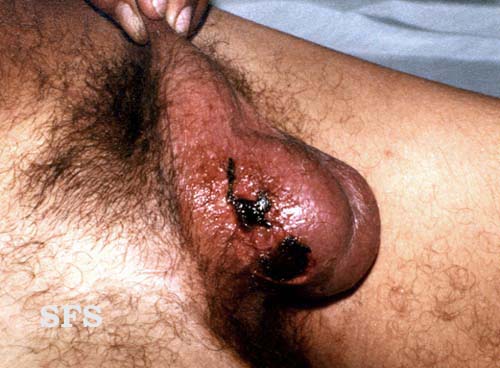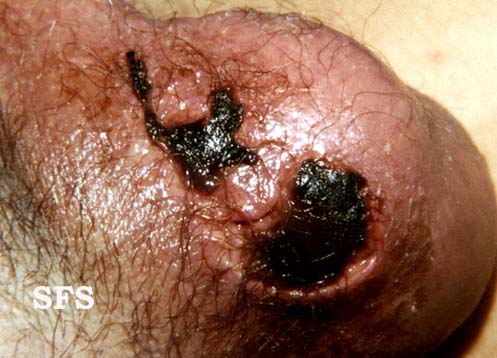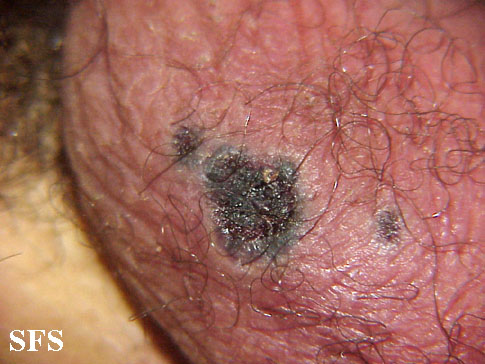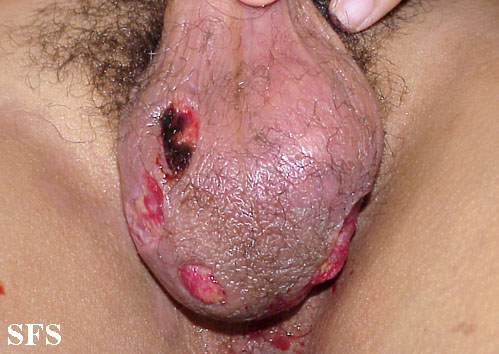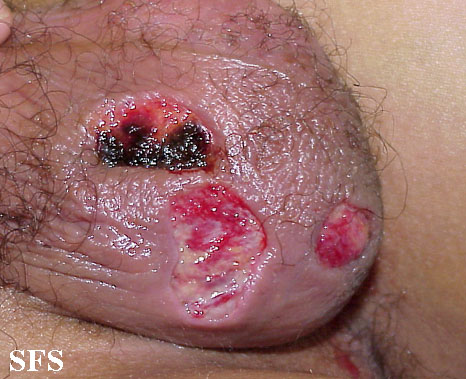Fournier gangrene
|
WikiDoc Resources for Fournier gangrene |
|
Articles |
|---|
|
Most recent articles on Fournier gangrene Most cited articles on Fournier gangrene |
|
Media |
|
Powerpoint slides on Fournier gangrene |
|
Evidence Based Medicine |
|
Cochrane Collaboration on Fournier gangrene |
|
Clinical Trials |
|
Ongoing Trials on Fournier gangrene at Clinical Trials.gov Trial results on Fournier gangrene Clinical Trials on Fournier gangrene at Google
|
|
Guidelines / Policies / Govt |
|
US National Guidelines Clearinghouse on Fournier gangrene NICE Guidance on Fournier gangrene
|
|
Books |
|
News |
|
Commentary |
|
Definitions |
|
Patient Resources / Community |
|
Patient resources on Fournier gangrene Discussion groups on Fournier gangrene Patient Handouts on Fournier gangrene Directions to Hospitals Treating Fournier gangrene Risk calculators and risk factors for Fournier gangrene
|
|
Healthcare Provider Resources |
|
Causes & Risk Factors for Fournier gangrene |
|
Continuing Medical Education (CME) |
|
International |
|
|
|
Business |
|
Experimental / Informatics |
Steven C. Campbell, M.D., Ph.D.; Associate Editor(s)-in-Chief: Yamuna Kondapally, M.B.B.S[1]; Jesus Rosario Hernandez, M.D. [2]
Synonyms and keywords: Idiopathic gangrene of scrotum; Periurethral phlegmon; Streptococcal scrotal gangrene
| Fournier gangrene | |
| ICD-10 | N49.8 (ILDS N49.81), N76.8 |
|---|---|
| ICD-9 | 608.83 |
| DiseasesDB | 31119 |
| MeSH | D018934 |
Overview
Fournier gangrene is a type of necrotizing infection (gangrene) of the perineal, genital or perianal regions usually affecting the male genitals but can also occur in female and children.[1] It is a fulminant form of necrotizing fasciitis. It was first described by Baurienne in 1764 and is named after a French venereologist, Jean-Alfred Fournier following five cases he presented in clinical lectures in 1883.[2][3]
Historical Perspective
- Fournier's gangrene was first described by in 1764 by Baurienne.[2]
- The detailed description of fournier's gangrene was given by Jean Alfred Fournier, who is a French venereologist in 1883.[3]
Classification
Pathophysiology
Causes
Aetiology
In the majority of cases Fournier gangrene is a mixed infection caused by both aerobic and anaerobic bacteria.[4]
Differentiating Fournier gangrene from Other Diseases
Epidemiology and Demographics
Incidence
Only 600 cases of Fournier gangrene were reported in the world literature in the ten years since 1996, with most patients in their 60s or 70s with other concurrent illnesses.[5] However, Fournier's gangrene is not a reportable illness, and the condition is not uncommon, especially among diabetic individuals. A similar infection in women has been occasionally described.[6]
In Turkey it was reported that 46% of patients had diabetes mellitus[7] whilst other studies have identified approximately a third of patients having either diabetes, alcoholism or malnutrition, and 10% having medical immunosuppression (chemotherapy, steroids, malignancy).[8]
Risk Factors
Common risk factors in the development of fournier's gangrene are:[9][10][11]
- Comorbid systemic disorders
- Age>50 yrs
- Male Gender
- Diabetes mellitus
- Alcohol misuse
- Immunosupression
- Chemotherapy
- Chronic corticosteroid use
- HIV
- Leukemia
- Liver disease
- Debilitating illness
- Malignancy
- Cytotoxic drugs
The most common foci of fournier's gangrene include:[12][13]
| Anorectal | Genitourinary | Dermatology | Gynaecological |
|---|---|---|---|
|
|
|
|
Screening
Natural History, Complications, and Prognosis
Diagnosis
Diagnostic Criteria
History and Symptoms
Physical examination
Gallery
Genitourinary system
Laboratory Findings
Imaging Findings
Other Diagnostic Studies
Treatment
Medical Therapy
Fournier gangrene is a urological emergency requiring intravenous antibiotics and debridement (surgical removal) of necrotic (dead) tissue. Despite such measures, the mortality rate overall is 40%, but 78% if sepsis is already present at the time of initial hospital admission.[7]
Antimicrobial Therapy
- Fournier gangrene[14]
- If caused by streptococcus species or clostridia
- Preferred regimen: Penicillin G
- Polymicrobial
-
- MRSA (methicillin resistant staphylococcus aureus) suspected
- Preferred regimen: vancomycin OR daptomycin
Surgery
Prevention
External links
References
- ↑ Smith GL, Bunker CB, Dinneen MD (1998). "Fournier's gangrene". Br J Urol. 81 (3): 347–55. PMID 9523650.
- ↑ 2.0 2.1 Nathan B (1998). "Fournier's gangrene: a historical vignette". Can J Surg. 41 (1): 72. PMC 3950066. PMID 9492752.
- ↑ 3.0 3.1 Chennamsetty A, Khourdaji I, Burks F, Killinger KA (2015). "Contemporary diagnosis and management of Fournier's gangrene". Ther Adv Urol. 7 (4): 203–15. doi:10.1177/1756287215584740. PMC 4580094. PMID 26445600.
- ↑ Thwaini A, Khan A, Malik A, Cherian J, Barua J, Shergill I, Mammen K (2006). "Fournier's gangrene and its emergency management". Postgrad Med J. 82 (970): 516–9. PMID 16891442.
- ↑ Vaz I (2006). "Fournier gangrene". Trop Doct. 36 (4): 203–4. PMID 17034687.
- ↑ Herzog W (1987). "[Fournier gangrene--also in females?]". Zentralbl Chir. 112 (9): 564–76. PMID 2956804.
- ↑ 7.0 7.1 Yanar H, Taviloglu K, Ertekin C, Guloglu R, Zorba U, Cabioglu N, Baspinar I (2006). "Fournier's gangrene: risk factors and strategies for management". World J Surg. 30 (9): 1750–4. PMID 16927060.
- ↑ Tahmaz L, Erdemir F, Kibar Y, Cosar A, Yalcýn O (2006). "Fournier's gangrene: report of thirty-three cases and a review of the literature". Int J Urol. 13 (7): 960–7. PMID 16882063.
- ↑ Clayton MD, Fowler JE, Sharifi R, Pearl RK (1990). "Causes, presentation and survival of fifty-seven patients with necrotizing fasciitis of the male genitalia". Surg Gynecol Obstet. 170 (1): 49–55. PMID 2294630.
- ↑ Morpurgo E, Galandiuk S (2002). "Fournier's gangrene". Surg Clin North Am. 82 (6): 1213–24. PMID 12516849.
- ↑ Vick R, Carson CC (1999). "Fournier's disease". Urol Clin North Am. 26 (4): 841–9. PMID 10584624.
- ↑ Eke N (2000). "Fournier's gangrene: a review of 1726 cases". Br J Surg. 87 (6): 718–28. doi:10.1046/j.1365-2168.2000.01497.x. PMID 10848848.
- ↑ Amendola MA, Casillas J, Joseph R, Antun R, Galindez O (1994). "Fournier's gangrene: CT findings". Abdom Imaging. 19 (5): 471–4. PMID 7950832.
- ↑ Gilbert, David (2015). The Sanford guide to antimicrobial therapy. Sperryville, Va: Antimicrobial Therapy. ISBN 978-1930808843.
